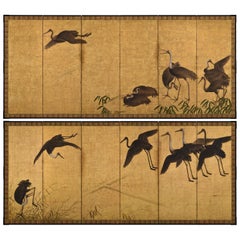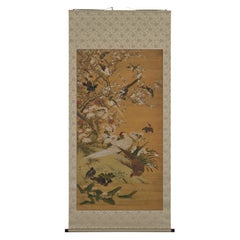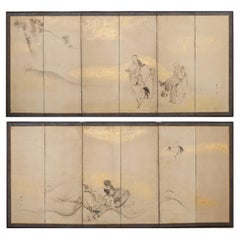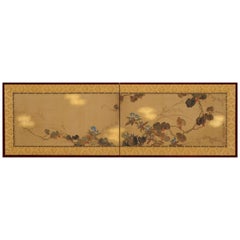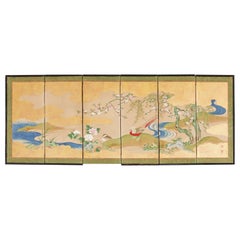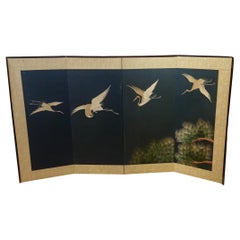Japanese Paintings and Screens
to
134
485
182
872
47
23
9
1
120
349
403
47
178
79
20
25
3
23
10
1
5
14
10
2
493
483
423
331
320
1,590
1,420
919
446
132
919
916
917
29
3
2
2
1
Place of Origin: Japanese
17th Century Japanese Screen Pair. Flock of Cranes. Ink and color on gold leaf.
Located in Kyoto, JP
A pair of six-fold Japanese screens from the 17th century depicting a flock of cranes arriving at their wintering grounds. The expansive scene is heavily atmospheric. The cranes are...
Category
17th Century Edo Antique Japanese Paintings and Screens
Materials
Gold Leaf
19th Century Japanese Scroll Painting, Birds & Flowers of the Four Seasons
Located in Kyoto, JP
Birds and flowers of the four seasons
Early to mid-19th century
Ink, pigment and gofun on silk
Unidentified artist
Signature: S...
Category
1830s Edo Antique Japanese Paintings and Screens
Materials
Silk
Pair of 18th Century Japanese Edo Screens of Chinese Immortals
Located in Rio Vista, CA
Mesmerizing pair of late 18th/early 19th century Japanese Edo period byobu screens by Shibata Gito (Japanese 1780-1819). The paintings depict Chinese immortals in a dreamy landscape....
Category
18th Century Edo Antique Japanese Paintings and Screens
Materials
Silk, Wood, Paper
Japanese Screen Painting, Early 19th Century, Autumn Flowers by Sakai Hoitsu
Located in Kyoto, JP
A two-fold Japanese screen by the Rimpa school artist Sakai Hoitsu (1761-1828), Japan, 19th century, Edo period.
This small Japanese folding screen pai...
Category
Early 19th Century Edo Antique Japanese Paintings and Screens
Materials
Wood, Silk
Japanese Edo Six Panel Table Screen After Maruyama Okyo
Located in Rio Vista, CA
Fantastic diminutive Japanese Edo period table top screen depicting a lively water landscape with flora and fauna. The screen is beautifully painted o...
Category
19th Century Edo Antique Japanese Paintings and Screens
Materials
Brass, Gold Leaf
Antique Japanese Folding Chamber Screen / Paravent 20th century Japan Cranes
Located in Amsterdam, Noord Holland
A super nice Meiji period 19th c Japanese Chamber Screen. Also usuable as wall mounted screen.
Stunning piece!
Category
20th Century Meiji Japanese Paintings and Screens
Materials
Bronze
$4,492 Sale Price
20% Off
17th Century Japanese Screen Pair. Tiger & Dragon by Kaiho Yusetsu
Located in Kyoto, JP
Kaiho Yusetsu (1598-1677)
Tiger and Dragon
Early Edo Period, Circa 1650
A Pair of Six-fold Japanese Screens. Ink and slight color on paper.
Dimensions:
Each screen: H. 171 cm x W. 380 cm (67.5’’ x 149.5’’)
In this pair of early Edo period Japanese screens a group of tigers prowl in a bamboo grove whipped with fierce wind, while a dragon claws through clouds and mist. The dragon embodies elemental qualities - looming out of the mist, the coils of its body disappearing in the clouds. The dragon is calling for rain, symbolizing spring which is considered the fountain of life. On the other side, the tigers calls for the wind, symbolizing autumn which is considered the end of life. Tigers were familiar motifs within Japanese art from ancient times though the animals were imaginary to the people in the 17th century. While dragons and tigers are usually associated as sacred and ferocious, in this painting, both animals have rather amusing expressions. The tigers appear to glare at the dragon with cat-like eyes, and the look on the swirling dragon’s face appears almost affectionate - lending a playful flair to an otherwise magnificent theme.
The tiger and dragon are cosmological symbols of the balancing forces in the world. Screens such as this were originally meant to express the fluctuating nature of the world. For Japanese in the early Edo period, they likely suggested the powers of the cosmos. In Japan the tiger and dragon motif was originally absorbed into the circles of Zen monasteries before spreading into the secular world. The theme especially appealed to the military classes with the Kano school, the official painters to the Shogun and the samurai, being the leading contributors. The painter of this pair of screens, Kaiho Yusetsu (1598-1677), was closely patronized by the third Shogun Tokugawa Iemitsu. In his later years he worked with Kano school artists...
Category
Mid-17th Century Edo Antique Japanese Paintings and Screens
Materials
Silk, Wood, Paper
18th Century Japanese Screen Pair. Plum & Young Pines. Kano School.
Located in Kyoto, JP
Dimensions (Each screen): H. 176 cm x W. 378 cm (69’’ x 149’’)
This pair of Japanese folding screens depict blossoming plum trees amongst young pines. They are designed to capture t...
Category
Late 18th Century Edo Antique Japanese Paintings and Screens
Materials
Gold Leaf
19th Century Japanese Screen Pair. Tiger & Dragon by Tani Bunchu.
Located in Kyoto, JP
Tani Bunchu (1823-1876)
Tiger and Dragon
A pair of six-panel Japanese screens. Ink on paper.
In this grand pair of Japanese Ryuko-zu screens the tiger crouches low to the ground, ...
Category
Mid-19th Century Edo Antique Japanese Paintings and Screens
Materials
Wood, Paper
Japanese Set of Two Excellent Birds And Dragonfly Shoji Doors Screens
Located in South Burlington, VT
Japan, an excellent pair/set of two (2) shoji "Birds and Dragonfly" bamboo doors or screens recently acquired from a Japanese private collector. The hand carved boards are artisti...
Category
Early 20th Century Taisho Japanese Paintings and Screens
Materials
Bamboo, Wood
$796 Sale Price / set
20% Off
17th Century Japanese Edo Four Panel Screen Hotei with Chinese Sages
Located in Rio Vista, CA
Beautifully weathered late 17th/early 18th century Japanese edo period four panel byobu screen depicting hotei (fat monk) in a treed landscape with Chinese sages engaged in leisurely...
Category
17th Century Edo Antique Japanese Paintings and Screens
Materials
Brass
Japanese Screen Landscape on Gold Leaf with Inks
By Japanese Studio
Located in Brescia, IT
Six-panel screen from the Tosa school painted with ink on gold leaf depicting a relaxing oriental landscape with pagodas, figures on boats and a beautiful sun in the sky.
The screen ...
Category
Late 19th Century Meiji Antique Japanese Paintings and Screens
Materials
Gold Leaf
Vintage Framed Japanese Watercolour on Silk Signed C.1960
Located in London, GB
Vintage Framed Japanese Watercolour on Silk Signed , C.1960
Depicting cherry blossom, the national flower of Japan, and a sparrow in flight, a symbol of loyalty, friendship and prosp...
Category
Mid-20th Century Japanese Paintings and Screens
Materials
Silk
Antique Japanese Taisho Period Byobu Four Panel Folding Screen
Located in New York, NY
Antique Byobu Four Panel Screen.
Japan, late 19th to early 20th century. Taisho period.
Category
Late 19th Century Antique Japanese Paintings and Screens
Materials
Paper
Pair of Japanese Meiji Screens Blossoms of Spring, Summer and Autumn
Located in Rio Vista, CA
Amazing pair of late 19th/early 20th century Japanese Meiji period byobu screens depicting flowering plants and blossoms of the spring, summer, and autumn. Painted in the Nihonga sch...
Category
19th Century Meiji Antique Japanese Paintings and Screens
Materials
Brass, Gold Leaf
East Asian Extra Wide Folding Low Six Panel Landscape Divider Screen
Located in Germantown, MD
A 95 inches East Asian Extra Wide Folding Low Six Panel Landscape Divider Screen with beautiful landscape scenes.
Measures 95" in width, 33" in height and 1" thick.
Category
Mid-20th Century Anglo-Japanese Japanese Paintings and Screens
Materials
Metal
Antique Framed Japanese Shunga Woodblock Print of a Couple Making Love
Located in Yonkers, NY
An antique Japanese Shunga woodblock print in gilt frame depicting a man and a woman making love. Created in Japan, this woodblock print called...
Category
19th Century Antique Japanese Paintings and Screens
Materials
Glass, Wood, Paint
Vintage Framed Japanese Watercolour on Silk Signed C.1960
Located in London, GB
Vintage Framed Japanese Watercolour on Silk Signed C.1960
Depicting cherry blossom, the national flower of Japan, and a seated sparrow, a symbol of loyalty, friendship and prosperity...
Category
Mid-20th Century Japanese Paintings and Screens
Materials
Silk, Paint
Byobu - Japanese Folding Screen
By Japanese Studio
Located in Brescia, IT
Nice four-panel Japanese screen painted on vegetal paper, depicting a landscape with a red maple, flowers and birds.
The size is very refined and easy to place in a design project.
Category
Mid-20th Century Showa Japanese Paintings and Screens
Materials
Paper
Japanese Kano School Four Panel Screen Birds and Owl
Located in Rio Vista, CA
Amazing 19th century Japanese Meiji period four-panel byobu screen featuring painted panels depicting egrets, heron, pheasants, songbirds, and an owl. Painted with ink and natural co...
Category
19th Century Meiji Antique Japanese Paintings and Screens
Materials
Gold Leaf
Japanese Showa Two Panel Screen Spring Flora and Fauna
Located in Rio Vista, CA
Spectacular Japanese Showa period two panel byobu screen featuring spring blossoms, birds, and butterflies. Beautifully detailed iris, lily, rose of sharon, wild pinks, morning glory...
Category
20th Century Showa Japanese Paintings and Screens
Materials
Wood, Paper
19th Century Japanese Paintings. Zenga Tiger and Dragon by Inoue Kanshu.
Located in Kyoto, JP
Inoue Kanshu (1807-1880)
Zenga Tiger and Dragon
19th century
Pair of framed Japanese paintings. Ink on silk.
Dimensions (each): W. 114 cm x H. 115 cm (45” x 45”)
Presented here ...
Category
Mid-19th Century Meiji Antique Japanese Paintings and Screens
Materials
Silk
Japanese Mid-Century Cloisonne Enamel Table Screen by Inaba
By Inaba Cloisonne Co.
Located in Newark, England
SIGNED WITH THE INABA MARK
From our Japanese collection, we are pleased to offer this Japanese Cloisonne Enamel Table Screen by Inaba. The Cloisonne Enamel Table screen with four in...
Category
Mid-20th Century Mid-Century Modern Japanese Paintings and Screens
Materials
Brass, Enamel
Japanese Miniature Four-Panel Screen Blue and Green Landscape
Located in Rio Vista, CA
19th century mid-Edo period Japanese four-panel miniature screen. Depicting a beautifully painted Chinese blue and green landscape in the Nanga School...
Category
19th Century Edo Antique Japanese Paintings and Screens
Materials
Brass
Circa 1700 Japanese Sliding Door (Fusuma) Set. Pine Trees on the Seashore.
Located in Kyoto, JP
"Pine Trees on the Seashore"
A set of four sliding doors (Japanese fusuma). Ink, color, gold-leaf and gold-fleck on paper.
Dimensions (total display si...
Category
Late 17th Century Edo Antique Japanese Paintings and Screens
Materials
Gold Leaf
Japanese Large Contemporary Yellow Black Gilded Raised Silk Folding Screen
Located in Takarazuka, JP
Japanese contemporary two panel folding screen or "byobu" featuring genryoku style handcrafted raised silk kimono in yellow, black and gold on a cream color background. Tagasode is t...
Category
21st Century and Contemporary Japanese Paintings and Screens
Materials
Silk, Brocade
Mid-20th Century Japanese silk embroidered framed painting
Located in Delft, NL
Mid-20th Century Japanese silk embroidered framed painting
A silk embroidered painting and is framed behind glass with a scene of women in ...
Category
Mid-20th Century Japanese Paintings and Screens
Materials
Silk
Japanese Folding Screen Six Panels Painted on Gold Leaf
By Japanese Studio
Located in Brescia, IT
Paravento a sei pannelli di scuola giapponese Kano: paesaggio con bellissime ed eleganti gru vicino al fiume, con alberi di pino e sakura.
Dipinto a mano con pigmenti minerali ed inc...
Category
Early 19th Century Edo Antique Japanese Paintings and Screens
Materials
Gold Leaf
Japanese Screen mid Edo gold leaf
By Japanese Studio
Located in Brescia, IT
This 18th century six-panel screen is truly special. The author is unknown, but his singular genius in portraying dozens of chrysanthemum flowers created with the white of the "gofun...
Category
Mid-18th Century Edo Antique Japanese Paintings and Screens
Materials
Gold Leaf
Large Japanese 6-panel byôbu 屏風 (folding screen) with chrysanthemum garden
Located in Amsterdam, NL
A very colourful and captivating large six-panel byôbu (folding screen) with a refined continuous painting of a luscious flower garden filled with many different types of chrysanthemums (kiku), next to a winding river.
This multi-coloured painting is set on a shiny gold-leaf background, and the chrysanthemum flowers are painted by using shell paste (gofun) in low relief.
Several clutches with a great variety of chrysanthemum flowers are in full bloom and they each show their unique form and colour. Varying from white, red, yellow and pink. The flowers bloom all around and on different kinds of bamboo fences and trellises.
In Japan chrysanthemums are believed to represent happiness, love, longevity and joy.
The panels are surrounded by two silk borders, a thin black one, and a wide brown one. The screen is protected by a black and red negoro’nuri...
Category
Late 19th Century Antique Japanese Paintings and Screens
Materials
Gold Leaf
Artists Kashiro Ashimi Meiji Period Bird Scroll Japan 20c Artist Nihonga
Located in Amsterdam, Noord Holland
As you can see, Kashiro Asami brush flower and bird (sparrow) figure Axle.
In addition to the flowers expressed in simple yet calm shades, the
bird (sparrow) seen at the top is a w...
Category
20th Century Showa Japanese Paintings and Screens
Materials
Silk
$737 Sale Price
20% Off
Pair of Japanese kakejiku 掛け軸 (hanging scrolls) depicting Niô guardians 仁王
Located in Amsterdam, NL
Pair of impressive, antique kakejiku (hanging scrolls) showcasing the awe-inspiring Niô guardians, also referred to as heavenly kings.
Each painting cap...
Category
Early 18th Century Antique Japanese Paintings and Screens
Materials
Brocade, Silk, Paint
Japanese Edo Four Panel Screen Flowering Peony Prunus Magnolia
Located in Rio Vista, CA
Early 19th century Japanese Edo/Tokugawa period four panel folding byobu table screen featuring peony, prunus, and magnolia. Painted with ink and natural color pigments on silk with ...
Category
19th Century Edo Antique Japanese Paintings and Screens
Materials
Brass
Late 17th Century Japanese Screen Pair. Battle of Ichi-no-tani and Yashima.
Located in Kyoto, JP
Anonymous
Late 17th Century
Battle of Ichi-no-tani & Yashima
Dimensions: Each Screen: H. 175 cm x W. 385 cm (69” x 151.5”)
This pair of Japanese screens depict two significant battles from the Genpei War (1180–85), as recounted in the Tale of the Heike, a semi-historical epic chronicling the conflict between rival clans for control of Japan, written in the early 1200s.
Each screen portrays a single battle through a series of small episodes, framed by gold clouds, landscape elements, and architectural features. True to the style of many screens inspired by The Tale of the Heike, the scenes are rendered in lavish colors and gold, downplaying the brutality of the warfare. Although based on real events, these narratives often glorified and romanticized the heroic feats of the warriors. Viewers at the time would have been familiar with the story’s details, leading to a proliferation of paintings on folding screens inspired by this theme from the late Muromachi to the early Edo periods.
On the right screen, we see the Minamoto’s attack on the Taira, who have retreated from the capital, Kyoto, toward the sea. The central building represents the temporary Taira headquarters, where Taira soldiers are holding the young Emperor Antoku. The Minamoto plan to launch a surprise attack from the rear after descending the steep cliff known as Ichi-no-tani, depicted at the top center. This scene highlights the tactical brilliance of Minamoto commander Yoshitsune and the courage of his men.
The left screen captures moments from the Battle of Yashima...
Category
Late 17th Century Edo Antique Japanese Paintings and Screens
Materials
Gold Leaf
18th Century Japanese Floral Paintings, Set of 5, Mineral Pigments on Gold Leaf
Located in Kyoto, JP
A set of 5 Japanese floral paintings from the 18th century. Each painted with mineral pigments directly applied to gold leaf. They were originally designed to be mounted on the leave...
Category
Mid-18th Century Edo Antique Japanese Paintings and Screens
Materials
Gold Leaf
Japanese Screen, Early 20th Century Wagtail & Chrysanthemum by Ishizaki Koyo
Located in Kyoto, JP
Ishizaki Koyo (1884-1947)
Wagtail & Chrysanthemum
Early 20th century
Folding screen in two-panels. Ink, pigments and gofun on gold leaf.
Sign: Koyo
Seal: Koyo
This ...
Category
Early 20th Century Taisho Japanese Paintings and Screens
Materials
Gold Leaf
Japanese Showa Four Panel Screen Autumn Flowers and Grasses
Located in Rio Vista, CA
Remarkable Japanese Showa period four-panel byobu screen depicting blossoming autumn flowers and grasses. The screen features a dramatic silver gilt square background that lends a da...
Category
20th Century Showa Japanese Paintings and Screens
Materials
Brass
19th Century Japanese Edo Six Panel Kano School Landscape Screen
Located in Rio Vista, CA
Late Edo period 19th century Japanese six-panel landscape screen featuring a cypress tree over a flowering hibiscus with a pair of hototogisu birds. Kano school painted with ink and ...
Category
19th Century Edo Antique Japanese Paintings and Screens
Materials
Silk, Wood, Paper
Japanese Ink and Watercolor 4-Panel Floor Screen
Located in Astoria, NY
Japanese Four-Panel Floor Screen, Ink and Watercolor on Paper, mounted on board, depicting mountainous landscape scene with seaside village. Panel: 55.25" H x 24.75" W; whole: 99" W....
Category
20th Century Meiji Japanese Paintings and Screens
Materials
Wood, Paint, Paper
Edo Landscape Japanese Folding Screen
By Japanese Studio
Located in Brescia, IT
Refined work by a painter from the first half of the 19th century, from the landscape of the "Rinpa" school by a painter from the end of the 18th century, the Rinpa school.
Six panels painted in ink on gold leaf and "gofun" on vegetable paper.
The flowers are made with the "gofun" technique, natural or pigmented white oyster powder.
Rinpa is one of the major historical schools of Japanese painting. The style was consolidated by the brothers Ogata Korin (1658–1716) and Ogata Kenzan (1663–1743).
This folding screen has a very clean design that leaves plenty of room for the beautiful golden landscape.
It comes flat and you can easily hang it with our hooks.
Lucio Morini...
Category
18th Century Edo Antique Japanese Paintings and Screens
Materials
Gold Leaf
Japanese Antique Bold Hand-Painted "Two Horses" Silk Scroll, Meiji Period
Located in South Burlington, VT
A bold, spectacular Japanese hand-brushed, hand-painted silk scroll of two horses below plumb tree mountain- worthy of your favorite room
Hand painting on silk in simple soft pleasin...
Category
Late 19th Century Meiji Antique Japanese Paintings and Screens
Materials
Silk
Japanese Folding Screen Landscape paint on Gold Leaf Six Panels
By Japanese Studio
Located in Brescia, IT
Folding screen depicting a landscape by a painter of the Rinpa school, early 19th century.
Six panels painted in ink on gold leaf and "gofun" on vegetable paper.
Rinpa is one of the ...
Category
Early 19th Century Edo Antique Japanese Paintings and Screens
Materials
Gold Leaf
Japanese Meiji Eight Panel Screen Village Landscape with Figures
Located in Rio Vista, CA
Large 19th century Japanese Meiji period eight panel byobu screen featuring a panoramic village landscape. The serene painting depicts agricultural scenes with villagers engaged in p...
Category
19th Century Meiji Antique Japanese Paintings and Screens
Materials
Gold Leaf
B49 Old Japanese Silver folding screen, Byobu 2panel
Located in Niiza, JP
Unfolded size: 1740 x 1750 x 15 mm
Foldable: 870 x 1750 x 35 mm, 5kg
Estimated size after packaging (sandwiched between 5-10 mm plywood):
10 cm x 95 cm x 185 cm Weight 29 KG
An at...
Category
19th Century Antique Japanese Paintings and Screens
Materials
Paper
Japanese Painting. Bird and Flower. 19th century copy of Lu Ji by Ogata Tomin.
Located in Kyoto, JP
Ogata Tomin (1839 -1895)
Birds in a spring landscape
Ink and colour on silk.
Inscription reads:
“Copy of Lu Ji, painted with heartfelt appreciation”
“Painted by Tomin Ogat...
Category
Late 19th Century Ming Antique Japanese Paintings and Screens
Materials
Silk
Japanese Framed Silk Painting, Turtledoves and Peaches, Taisho Era, circa 1920
Located in Kyoto, JP
Nakamura Daizaburo
Turtledoves in a Peach Tree
Taisho period, circa 1920
Framed painting. Mineral pigments, ink and gofun on silk
Signed: Daizaburo
Dimensions (framed)...
Category
1910s Taisho Vintage Japanese Paintings and Screens
Materials
Wood, Silk
Japanese Meiji Six Panel Screen Kano School Bird Waterscape
Located in Rio Vista, CA
Stunning late 19th century Japanese Meiji period six panel byobu screen featuring a deep blue waterscape with pheasants and ducks. Made in the Kano sch...
Category
19th Century Meiji Antique Japanese Paintings and Screens
Materials
Brass, Gold Leaf
Signed Japanese Meiji Period Table Top Screen, circa 1890
Located in San Francisco, CA
Meiji period Japanese lacquered and hand painted folding table top screen.
The bas relief (heavily textured) sculptural painting of a serene quiet nature setting in an intricately ca...
Category
Late 19th Century Meiji Antique Japanese Paintings and Screens
Materials
Wood, Lacquer, Paint
Circa 1920 Japanese Screen. Cat & Mouse Harvest Scene on Gold Silk.
Located in Kyoto, JP
The narrative playfulness of the scene depicted on this Japanese screen sets alight what is at its core a celebration of a bountiful harvest. The screen offers a visual representatio...
Category
Early 20th Century Taisho Japanese Paintings and Screens
Materials
Gold
Byobu- Japanese Folding Screen Gold Leaf
By Japanese Studio
Located in Brescia, IT
Japanese six-panel screen from the Kano school: Japanese landscape with an elegant crane.
Hand painted with mineral pigments and gold leaf inks.
The pure gold leaf is laid with great...
Category
Late 19th Century Meiji Antique Japanese Paintings and Screens
Materials
Gold Leaf
Japanese Showa Two Panel Screen Blossoming Prunus Tree
Located in Rio Vista, CA
Serene Japanese Showa period two-panel folding byobu screen depicting a large spring blossoming prunus tree or plum tree. Beautifully painted with ink and natural color pigments on m...
Category
20th Century Showa Japanese Paintings and Screens
Materials
Brass
Edo Period Kyoto Screen
Located in Fukuoka, JP
Edo Period Kyoto Screen
Period: Edo period
Size: 343 x 176 cm (134.6 x 69 inches)
SKU: RJ69
This stunning Edo period screen depicts typical scenes of d...
Category
18th Century Edo Antique Japanese Paintings and Screens
Materials
Silk, Wood, Paper
$9,450
Early 20th Century Japanese 6-Panel Gouache and Gold Leaf Painted Table Screen
Located in Morristown, NJ
20th c., Showa period gouache and gold leaf Japanese screen. Depicting plum tree blossoms on a riverbank across 6 panels. Plum blossoms are often mentioned in Japanese poetry as a symbol of spring...
Category
20th Century Showa Japanese Paintings and Screens
Materials
Gold Leaf
Japanese Six Panel Paper Screen
Located in Essex, MA
Six panel Tosa school with rich colors depicting a river and bridge. Featuring people in various pursuits. Descended in the Thayer family of Massachusetts.
Category
1750s Antique Japanese Paintings and Screens
Materials
Paper
Japanese Antiques 2panels, Silver back, Banana Plants, Rofuu folding Screen
Located in Niiza, JP
Material: Silver paper, wooden frame
One sheet: W870×H1740mm, unfolded size: W1740mm, 5kg
Folded size: W870×H1740×D35mm
Estimated packaging (sandwiched with 5-10mm plywood): 12cm x 1...
Category
19th Century Antique Japanese Paintings and Screens
Materials
Paper
Antique Japanese Six-Panel Screen by Kano Chikanobu "Shushin"
Located in Prahran, Victoria
Late 17th century Kano school peony landscape screens. Both screens signed: Hogan Josen Fujiwara Chikanobu Hitsu - Kano Chikanobu (Shushin) (1660 - 1728...
Category
Early 18th Century Edo Antique Japanese Paintings and Screens
Materials
Gold Leaf
Japanese Antiques 6panels, Gold back, crane and pine, Araki Jippo folding screen
Located in Niiza, JP
Material: gold background paper, wooden frame
One piece: W730 x H1760 mm, unfolded size: W4420 mm, 13 kg
Folded size: W750 x H1760 x D100 mm
Estimated packaging (sandwiched with 5 mm...
Category
Early 20th Century Japanese Paintings and Screens
Materials
Paper
Evolving Elegance: An Oxidized Silver Screen from the Meiji Period
Located in Fukuoka, JP
This anodized 6-panel screen captures the serene and minimalistic beauty of a bamboo grove, embodying the aesthetic principles of the Edo period. The screen features subtle and delic...
Category
18th Century Edo Antique Japanese Paintings and Screens
Materials
Silver Leaf
B10 Japanese Antiques 6panels, Paper, folding Screen with Flower & bird painting
Located in Niiza, JP
Flower and bird painting
Material: Paper on wooden frame, colored
One piece: W660×H1825mm×D20mm,
Unfolded size: W3860mm, 16kg
Folded size: W660×H1825×D110mm
Packaging (sandwiched wit...
Category
19th Century Antique Japanese Paintings and Screens
Materials
Paper
Vintage Handpainted Silk Japanese Geisha Screen With Ricepaper Backing
Located in Waxahachie, TX
1960-1970s
Hand painted silk.
Rice paper backing.
Made in Japan.
Six colorful Geisha surrounded by bamboo trees.
Little details, a shamisen, or Japanese guitar, a rice paper scroll...
Category
1970s Edo Vintage Japanese Paintings and Screens
Materials
Silk, Wood
$1,020 Sale Price
40% Off
Recently Viewed
View AllMore Ways To Browse
Lattice Panel Wood
Hanging Japanese Screen
Japanese Lattice
Japanese 19th Century Meiji Period Silk Painting
Japanese Buddhist Screen
Japanese Carved Screen
Japanese Screens And Doors
Japanese Autumn Screen
Japanese Screens Six Fold
Japanese Wood Room Divider
Kyoto Silk Painting
Japanese Dragon Painting
Japanese Birds Painted On Silk
Heian Period
Japanese Crane Panel
Japanese Divider Screen
Japanese Pheasant
Japanese Screen Chrysanthemums
